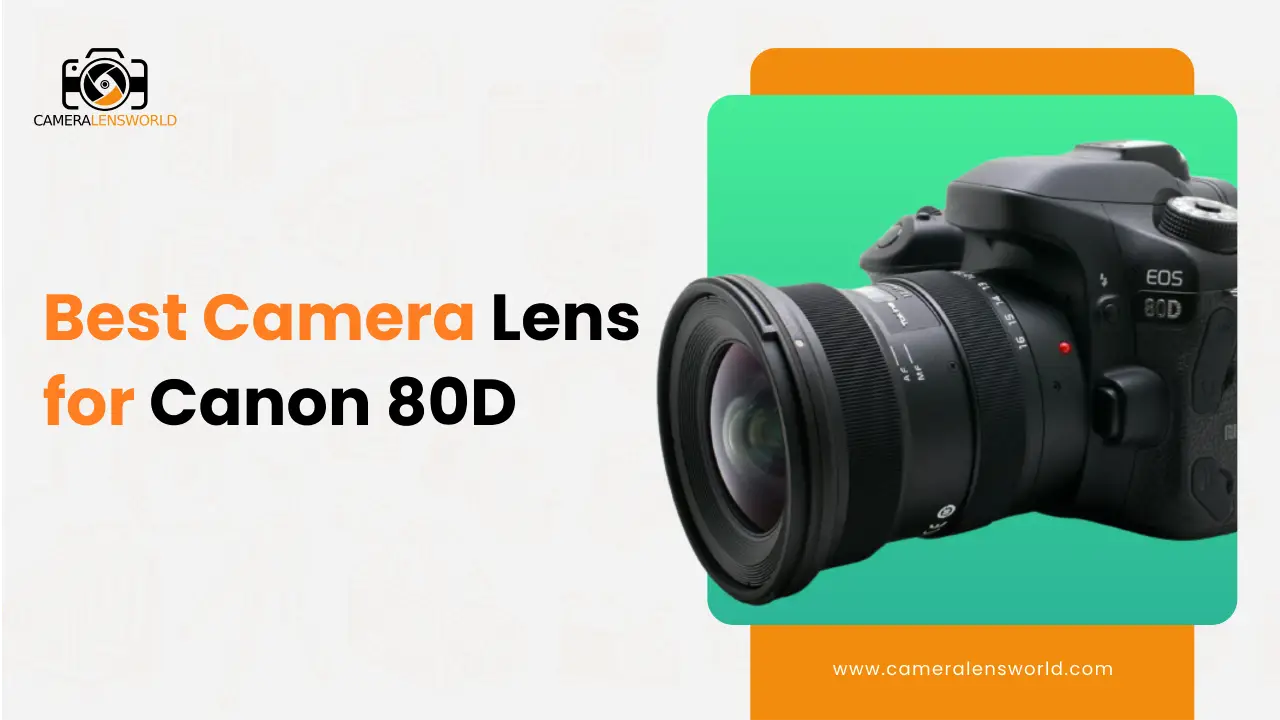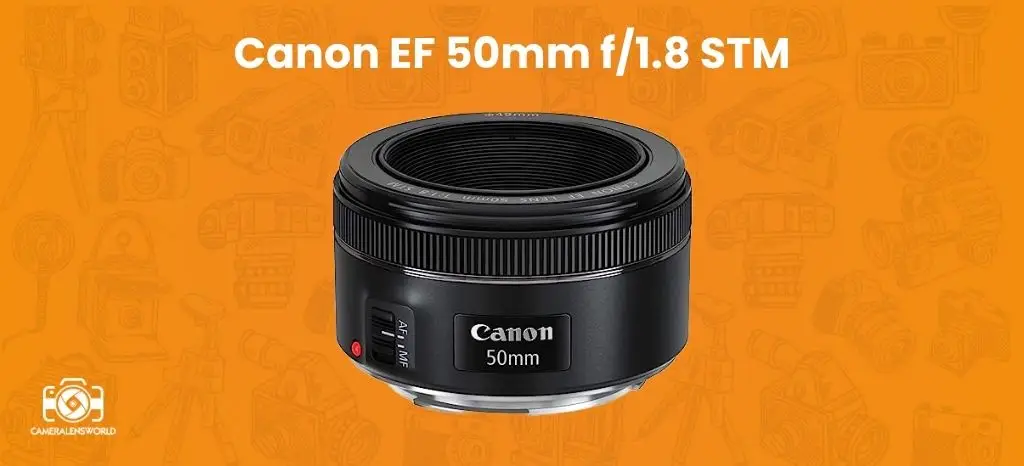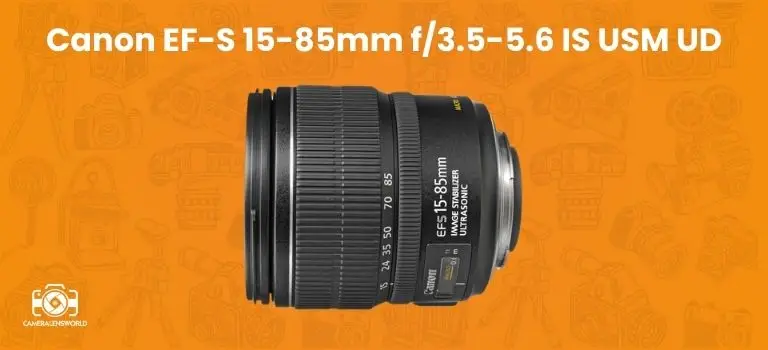
As a photography enthusiast with a keen eye for quality, I’ve always believed that a camera’s true potential lies in its lens. After extensive research, I am sharing my insights on the Best Camera Lens for Canon 80D.
The Canon 80D is a remarkable camera, and when paired with the right lens, it can truly capture the essence of any subject.
In my previous article, “Beginner’s Guide for Buying Camera Lenses,” I provided a foundation for choosing the ideal lens. Building on that knowledge, this article will focus specifically on the Canon 80D, outlining the top lens choices that will elevate your photography to new heights.
List of the best camera lens for Canon 80d [Quick review]
Here, I have compiled a quick list of the best camera lens for Canon 80d.
- Canon EF 50mm f/1.8 STM
- Canon 15-85mm f/3.5-5.6 IS USM
- Sigma 10-20mm f/3.5
- TOKINA ATX-i 11-16mm – Best Wedding Lens For Canon 80D
- Canon 70-300 mm f/4-5.6 IS USM
- Sigma 18-35mm f/1.8 DC HSM Art Lens
- Canon 10-22mm f/3.5-4.5 USM
- Tokina AT-X 14-20mm f/2 Pro DX Lens
- Canon EF-S 24mm f/2.8 STM
List of the best camera lens for Canon 80d [Detailed analysis]
Let’s now discuss in detail the best camera lens for Canon 80d.
1. Canon EF 50mm f/1.8 STM
- The Canon EF 50mm f/1.8 STM has a maximum aperture of f/1.8, which allows it to excel in low light.
- The lens is not properly weather-sealed.
- When shooting wide-open at f/1.8, you’ll see a lot of purple and green fringing. The fringing improves but remains at f/4 before disappearing at f/5.6.
| Brand | Sony |
| Maximum Focal length | 24 mm |
| Lens type | Wide angle |
| Compatible mounting | Sony |
| Weight | 847 g |
| No.of diaphragm blades | 9 circular blades |
| Lens construction | 17 elements in 14 groups |
Reasons to buy:
- Autofocus is quick and precis.
- When shooting a video, the focus is smooth.
- Even with an open aperture, the sharpness is excellent.
- Excellent work in the backlight.
Reasons to avoid:
- Autofocus that is quiet but not silent.
- The soft effect at open aperture and noticeable vignetting is up to f/2.8.
- Defining bokeh with harsh glares.
2. Canon 15-85mm f/3.5-5.6 IS USM
- The maximum aperture of the Canon 15-85mm lens is f/3.5-5.6.
- The filter size is 72mm.
- The lens is not properly weather-sealed.
- Chromatic aberration is well controlled.
| Brand | Canon. |
| Type | Standard lens. |
| Lens format coverage | APS-C cameras. |
| Compatible Mounting | Canon EF-S. |
| Image Stabilization | Available. |
| No.of diaphragm blades | 7 blades. |
| Lens construction | 17 elements in 12 groups. |
| Minimum focus distance | 0.35 m. |
| Weight | 570 g. |
| Adjustment | The lens offers both auto and manual focus capabilities. |
Reasons to buy:
- Sharpness is good at apertures 5.6-8.
- Excellent focal length
- In any light, fast AF.
- Quick, silent focus.
Reasons to avoid:
3. Sigma 10-20mm f/3.5
- The Sigma 10-20mm f/3.5 offers aperture f/3.5.
- The lens may not be properly weather-sealed.
- With f3.5, I saw that the image was only a little hazy.
- Furthermore, sharpness is exhibited at all edges while using f4. If you’re not likely to find individuals around the edges, the device is ideal for shooting them.
| Brand | Sigma. |
| Type | Wide angle lens. |
| Lens format coverage | APS-C format digital SLR. |
| Compatible Mounting | Nikon F (DX). |
| Image Stabilization | No image stabilization. |
| No.of diaphragm blades | 7 blades. |
| Lens construction | 13 elements in 10 groups. |
| Minimum focus distance | 24 cm. |
| Weight | 520 g. |
| Adjustment | The Hyper Sonic Motor (HSM) provides silent, high-speed AF. |
Reasons to buy:
- Excellent ergonomics
- Beautiful bokeh
- The focus ring moves easily and smoothly.
- AF is quiet and quick.
Reasons to avoid:
- Large filter thread diameter.
- In low light, the focus slows.
4. TOKINA ATX-i 11-16mm – Best Wedding Lens For Canon 80D
- I found this lens best for wedding photography.
- TOKINA ATX-i 11-16mm has a fixed maximum aperture of f/2.8.
- The filter thread size is 77 mm.
- The lens may not be properly weather-sealed.
- Usually, there are no issues with longitudinal chromatic aberration.
| Brand | Tokina. |
| Type | Wide angle lens. |
| Lens format coverage | APS-S. |
| Compatible Mounting | Canon EF. |
| Image Stabilization | No image stabilization. |
| No.of diaphragm blades | 9 blades. |
| Lens construction | 13 elements in 11 groups. |
| Minimum focus distance | 0.3 m. |
| Weight | 555 g. |
| Adjustment | Autofocus and manual focus ring. |
Reasons to buy:
- A lens with a very wide field of view.
- Suitable for use with graduated or polarized filters.
- Control over depth of field is superb.
- Images with strong contrast and sharpness.
Reasons to avoid:
- Autofocus is a little louder than others.
5. Canon 70-300 mm f/4-5.6 IS USM
- Canon 70-300 mm offers a maximum aperture of f/4-5.6.
- This Canon EOS 80D lens features the most sturdy and small body of any Canon EOS 80D lens.
- However, the stabilizer almost eliminates annoying visual wobble during video recording.
- It is a useful tool for videographers, too.
| Brand | Canon. |
| Type | Telephoto lens. |
| Lens format coverage | Canon’s full-frame and APS-C DSLR cameras. |
| Compatible Mounting | Canon EF. |
| Image Stabilization | Image Stabilizer with 3 stops. |
| No.of diaphragm blades | 8 blades. |
| Lens construction | 15 elements in 10 groups. |
| Minimum focus distance | 1.50 m. |
| Weight | 630 g. |
| Adjustment | Ring-type ultrasonic motor (USM). |
Reasons to buy:
- The vignette level is low.
- Excellent contrast even when sunlight falls on the front lens
- Autofocus is relatively quick.
- Image stabilizer optically effective
Reasons to avoid:
- With an open aperture, detalization decreases at the long end of the zoom range.
- Inadequate flare protection.
- Background blurring is relatively harsh.
6. Sigma 18-35mm f/1.8 DC HSM Art Lens
- The Sigma 18-35mm f/1.8 DC HSM Art Lens offers a maximum aperture of f/1.8.
- The filter thread size is 72 mm.
- The Sigma performs admirably in terms of chromatic aberration control.
- I found greater CA at wide-angle focal lengths, as predicted, but it lowers dramatically in both the corners and across the frame as I zoomed to 35mm.
| Brand | Sigma. |
| Type | Wide angle lens. |
| Lens format coverage | Full frame. |
| Compatible Mounting | Canon EF-S. |
| Image Stabilization | No image stabilization. |
| No.of diaphragm blades | 9 blades. |
| Lens construction | 17 elements in 12 groups. |
| Minimum focus distance | 28 cm. |
| Weight | 810 g. |
| Adjustment | AF motor with ring-type ultrasonic technology and full-time manual focusing. |
Reasons to buy:
- Suitable for various photography styles.
- Exceptional sharpness and image quality.
- Fast and accurate autofocus.
- Fast zoom lens.
Reasons to avoid:
- Heavy and expensive.
- Limited focal length range.
7. Canon 10-22mm f/3.5-4.5 USM
- The maximum aperture of the Canon 10-22mm is 3.5-4.5.
- The filter thread size is 77 mm.
- The chromatic aberration is slightly high at 10mm, but it steadily diminishes as the focal length is extended.
| Brand | Canon. |
| Type | Wide angle lens. |
| Lens format coverage | EOS digital SLRs. |
| Compatible Mounting | Canon EF-S. |
| Image Stabilization | No image stabilization. |
| No.of diaphragm blades | 6 blades. |
| Lens construction | 13 elements in 10 groups. |
| Minimum focus distance | 24 cm. |
| Weight | 385 g. |
| Adjustment | Superior AF performance and quickness, as well as full-time manual focus with a ring turn. |
Reasons to buy:
- Better low-light performance than Canon 10-18mm.
- Versatile wide-angle zoom.
- Good image quality.
- Compact and lightweight.
Reasons to avoid:
- Expensive.
- Some distortion at the widest focal lengths.
8. Tokina AT-X 14-20mm f/2 Pro DX Lens
- The Tokina AT-X 14-20mm f/2 Pro DX Lens offers a maximum of f/2.
- It has a multi-layer anti-reflection coating.
- Filter size is 82 mm.
- It provides good image quality and better chromatic aberration management.
| Brand | Tokina. |
| Type | Wide angle lens. |
| Lens format coverage | APS-C. |
| Compatible Mounting | Canon EF. |
| Image Stabilization | No image stabilization. |
| No.of diaphragm blades | 9 blades. |
| Lens construction | 13 elements in 11 groups. |
| Minimum focus distance | 0.28 m. |
| Weight | 725 g. |
| Adjustment | Internal Focus, One Touch Focus Clutch. |
Reasons to buy:
- Wide-angle versatility.
- Bright f/2 aperture.
- Good image quality.
- Suitable for low-light shooting.
Reasons to avoid:
- It may be heavy for some users.
- Not ideal for telephoto shooting.
9. Canon EF-S 24mm f/2.8 STM
- The Canon EF-S 24mm has a maximum aperture of f/2.8.
- The filter thread size is 52 mm.
- Extra seals protect the gadget from failures caused by dust, rain, and other elements.
- Chromatic aberration is controlled.
| Brand | Canon. |
| Type | Wide angle lens. |
| Lens format coverage | APS-C. |
| Compatible Mounting | Canon EF-S. |
| Image Stabilization | No image stabilization. |
| No.of diaphragm blades | 7 blades. |
| Lens construction | 6 elements in 5 groups. |
| Minimum focus distance | 0.16 m. |
| Weight | 125 g. |
| Adjustment | Full-time manual focus lens, you can override the focus system at any time. |
Reasons to buy:
- Best tiny lens.
- The brilliant aperture of f/2.8.
- Full-time Manual focus is great for video shooting.
Reasons to avoid:
What to look for in the best camera lens for Canon 80d
1- Aperture
When selecting the best lens aperture for your Canon 80D, consider factors like lighting and depth of field. For well-lit scenes, a wide aperture (e.g., f/1.8) allows more light and creates a beautiful background blur.
Smaller apertures (e.g., f/8 or higher) suit landscapes and ensure sharpness throughout. Adjust according to your creative intent. Experiment to find the perfect balance between light and focus, maximizing the capabilities of your Canon 80D.
2- Focal Length
When assessing the ideal focal length for your Canon 80D lens, consider your photography style. For portraits, a lens with a focal length of around 85mm provides flattering perspectives. Wider angles, like 24mm, are great for landscapes and group shots. Zoom lenses, such as 24-70mm, offer versatility.
Remember, longer focal lengths bring distant subjects closer but can be heavy. Determine your shooting preferences and choose accordingly to unleash the full potential of your Canon 80D.
3- Zoom Range
When evaluating the zoom range for your Canon 80D lens, prioritize versatility. Zoom lenses with a broad range, like 18-200mm, cover wide-angle to telephoto shots. For specific needs, consider lenses like 70-200mm, known for portrait and sports photography. A shorter zoom, such as 18-55mm, suits general use.
Remember, extensive zoom may sacrifice some image quality, while fixed focal length lenses offer better clarity but less flexibility. Select a zoom range that complements your photographic objectives, balancing convenience with image quality for your Canon 80D.
4- Image Stabilization
When gauging image stabilization in a Canon 80D lens, it’s essential for reducing blurriness caused by camera shake. Look for lenses with IS (Image Stabilization) or VR (Vibration Reduction) technology. This feature is especially crucial for telephoto or low-light shooting. Some lenses offer multiple IS modes, allowing you to adapt to different shooting conditions.
Additionally, consider if your Canon 80D body has in-body stabilization. Combining in-lens and in-body stabilization can provide even better results. Prioritize IS when selecting a lens, as it significantly enhances the quality of your photos, particularly in challenging situations.
Best camera lens for Canon 80d FAQs
What type of lens does a Canon 80D take?
The Canon EOS 80D utilizes the Canon EF/EF-S lens mount, designed for Canon’s full-frame and APS-C cameras. For photographers and multimedia creators, there are already hundreds of Canon and third-party EF and EF-S mount alternatives, making it a wonderful camera DSLR mount to invest in.
What is good about the Canon 80D?
The improved Dual Pixel CMOS AF allows you to shoot video with smooth, fast, and accurate autofocus, as well as still images with instant and exact autofocus. Canon’s enhanced Dual Pixel CMOS AF on the EOS 80D camera provides fast and smooth AF during Live View and movie shooting.
Is the 80D still a good camera?
The 80D is still a good camera. Have fun shooting if it’s a decent offer, and you don’t have a better deal on a 90D or a R7 (the obvious next steps up, in my opinion).
How do I make my Canon 80D pictures sharper?
ISO 200-400, f8,11, 1/500 sec. This will give you around 35 feet of sharp focus in front and behind your main subject. To utilize a f stop of 16 or higher, you’d have to increase the ISO and decrease the shutter speed. This would provide the greatest depth of field (foreground), topic (background), and contrast.
Conclusion
In conclusion, after thoroughly exploring the best Camera Lens for Canon 80D, I hope you now have a clearer vision of the lens that aligns with your photography ambitions.
Remember, the Canon 80D is a versatile canvas for your creativity, and the right lens is the brush that brings your vision to life. Your choice should be informed by your specific needs and the genres of photography you’re passionate about.
Now, armed with knowledge about the best Camera Lens for Canon 80D, it’s your turn to make the decision that best suits your photographic journey. May your lens choice open new horizons and inspire countless memorable moments behind the lens.
Happy shooting!



Leave a Reply
You must be logged in to post a comment.